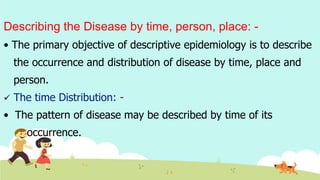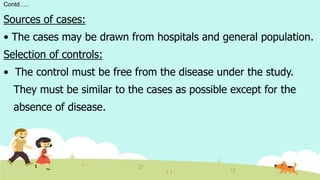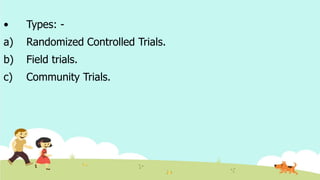EPIDEMIOLOGY ppt 2.pptx
- 1. EPIDEMIOLOGY
- 2. TOPICS: - Epidemiological Approaches Methods of Epidemiology
- 3. Epidemiological Approaches The epidemiological approach to problem of health is based on two measure foundations: Asking questions Making Comparisons
- 4. Asking Questions: - The epidemiologists ask a variety of questions and make observations related to nature and extent of problem, geographical distribution, time trend and personal characteristics of the person who gets the disease.
- 5. Contd… Related to Health Events: What is the event? What is its magnitude? Where did it happen? When did it happen? Who are affected? Why did it happen?
- 6. Contd… Related to Health Action: What can be done to reduce this problem and its consequences? How can it be prevented in the future? What action should be taken by the community? What resources are required? What difficulties may raise, and how might be they overcome?
- 7. Making Comparisons: - The basic approach in epidemiology is to make comparisons and draw inferences. Epidemiological approach is not only for an individual, but also for whole population .
- 8. Contd… • It is expressed in term of a)Rate = Data of illness Data of whole population at risk b)Prevalence Rate =Number of people with the Disease at a specified time. X 10n Number of people in the population at risk at the specified time
- 9. Contd… The prevalence rate is often expressed as cases per 1000 or per 100,000 populations: • Point prevalence rate: Data collected at one point of time. • Period prevalence rate: Data collected during a specified period.
- 10. Contd… c)Incidence Rate = Number of people who get a disease (new cases) in a specified period. Sum of the length of time during which each person in population is at risk.
- 12. Epidemiological methods are classified in to two: Observational Descriptive Analytical Experimental Randomized Community and field Trials
- 13. Descriptive Epidemiology: - Descriptive epidemiology is concerned with occurrence, size, distribution and progression of health and disease in population. These studies are usually the first phase of an epidemiological investigation. It gives information about who all are affected by a particular disease.
- 14. Following characteristics are examined in descriptive study: Time- Year, Season, Month, Week, Day, Hour of onset, Duration. Place- Climate zone, country, urban or rural region, local community, towns, cities, institutions. Person- Age, Sex, Marital status, Occupation, Social status, education, height, weight, family size.
- 15. STEPS IN DESCRIPTIVE STUDIES STEP 1 Define Populati on STEP 2 Define disease STEP 3 Describe disease by time, place and person STEP 4 Measure -ment of Disease STEP 5 Comp aring the known indice s STEP 6 Formul ation of Hypoth esis
- 16. Defining the population to be studied: - The first step is to define the population base not only in terms of the total number but also in composition in terms of age, sex, occupation and cultural characteristics. • The defined population needs to be large enough so that age, sex and other specified rates are meaningful.
- 17. Contd…. • The community should be stable, without migration into and out of area. • Also the population should not be overtly different from other communities in the region. • Finally, a health facility should be close enough to provide easy access for patients requiring medical facilities.
- 18. Defining the disease under study: - • Once the population to be studied is defined, one must then define the disease being investigated. • The clinician may not need a precise definition of disease for immediate patient care. If the diagnosis is wrong, he can revise it subsequently.
- 19. Contd…. • But the epidemiologist, who main concern is to obtain an accurate estimate of the disease, needs precise and valid definition to enable it. • So the epidemiologist looks for operational definition, i.e. the definition which can be identified and measured in defined population with a degree of accuracy.
- 20. Describing the Disease by time, person, place: - • The primary objective of descriptive epidemiology is to describe the occurrence and distribution of disease by time, place and person. The time Distribution: - • The pattern of disease may be described by time of its occurrence.
- 21. Contd…. • The epidemiologists have identified three kinds of time trends or fluctuations in disease occurrence: i. Short term fluctuations. ii. Periodic fluctuations iii. Long term or secular trends.
- 22. Contd…. i. Short term fluctuations: - • The best short term fluctuations are occurrence of an epidemic. • An epidemic is the occurrence in a community of an illness or other health related events clearly in excess of normal expectancy.
- 23. Contd…. ii. Periodic fluctuations: - A. Seasonal trend: For example, measles is at its height in early spring. Upper respiratory infections rise in winter months. GI infections are prominent in summer because of warm weather and rapid multiplication of flies.
- 24. Contd…. B. Cyclic trend: Some diseases occur in cyclic order over a short period of time which may be days, weeks, months or years. For example, measles in the pre vaccination era appeared in cycles with major peaks in every 2 to 3 years and rubella every 6 to 9 years.
- 25. Contd…. iii. Long term or Secular Trends: - The term “secular trend” implies changes in occurrence of disease over a long period of time, generally several years or decades.
- 26. Contd…. Place Distribution: - • Studies of geography of disease are one of the important dimensions of descriptive epidemiology. • By studying the distribution of disease in different population, we gain perspective on the fascinating differences in disease pattern not only between countries but also within countries.
- 27. Contd…. • The variation can be: a) International variation. b) National variation. c) Rural- Urban differences. d) Local distribution.
- 28. Contd…. Person’s Distribution: - • In descriptive studies the disease is further characterized by defining the person who develops the disease by age, sex, occupation, marital status, habits, social class and other host factors.
- 29. Contd…. Measurement of Disease: - • It is mandatory to have a clear picture of the amount of disease in the population. • This information should be available in terms of mortality, morbidity, disability and so on.
- 30. Contd…. Comparing with the Known Indices: - • The essence of epidemiology is to make comparisons and ask questions. • By making comparisons between different populations and subgroups of same population, it is possible to arrive at clues to disease etiology.
- 31. Formulation of Hypothesis: - • An epidemiological hypothesis should specify the following: a) The population: The characteristics of persons to whom the hypothesis implies. b) The specific cause being considered. c) The expected outcome of disease. d) The dose response relationship. e) The time response relationship.
- 32. Analytical Epidemiology: - Analytical studies are second major type of epidemiological studies. The subject of interest in analytical studies is an individual within the population. The object is not to formulate but to test the hypothesis.
- 33. It comprises two distinct types of observational studies: • Case- control studies. • Cohort studies. Case- control studies: - • Case- control study often called “retrospective studies” is a common first approach to study of test causal hypothesis.
- 34. • It has three distinct features: Both exposure and outcome have occurred before the start of the study. The study proceeds backward from effect to cause. It uses a control or comparisons group to support or refute an inference
- 35. Contd….. • Case- control study involves two populations: case and control. • Case control studies are basically comparison studies.
- 36. Contd….. • The four basic factors in conducting a case- control study Selection of case and control Matching Measurement of Exposure Analysis and Interpretation
- 37. Contd….. Selection of cases and control: - • The first step is to identify a suitable group of cases and group of controls. Definition of Cases: • According to the diagnostic criteria: The diagnostic criteria of the disease and the stage of the disease and the stage of disease
- 38. Contd….. to be included in the study must be specified before the study is undertaken. • According to the eligibility criteria: A criterion customarily employed is the requirement that only new cases within the specified period of time are eligible.
- 39. Contd….. Sources of cases: • The cases may be drawn from hospitals and general population. Selection of controls: • The control must be free from the disease under the study. They must be similar to the cases as possible except for the absence of disease.
- 40. Contd….. Sources of controls: • The possible sources from which controls can be selected are hospitals, neighbor's, relatives and general population. Matching: - • Matching is defined as the process by which we select control in such a way that they are similar to cases in regards to certain
- 41. Contd….. pertinent selected variables, which are known to influence the outcome of the disease and which, if not adequately matched, could distort or confound the results. • There are mainly two type of matching procedures: Group matching. Individual matching.
- 42. Contd….. Measurement of Exposure: - • Definition and criteria about exposure are just as important as those used to define cases and controls. • Information about exposure can be obtained by interviews, by questionnaire or by studying the past record.
- 43. Contd….. Analysis: - • The final step is an analysis to find out: Exposure the rates among cases and controls to the suspected factors. Estimation of disease risk associated with exposure.
- 44. Contd….. Advantages of retrospective studies: • Inexpensive and Easy • Require fewer subjects • Useful for rate of disease or diseases with long latency periods. • Can check for more than one risk factor. • Useful for drug induced illness.
- 45. Contd….. Disadvantages of retrospective studies: • Information not easily available. • Difficult to validate. • Quality of survey. • Bias in selection. • Recall may be flawed.
- 46. Contd….. Cohort studies: - • Cohort study is another type of analytical study which is usually undertaken to obtain additional evidence to refuse or support the existence of an association between suspected cause and disease. • It is also known as prospective study or incidence study or forward looking study.
- 47. The steps or elements of cohort study include Analysis Follow up Selection of comparison group Obtaining data on exposure Selection of study subject
- 48. Contd….. Selection of study subjects: • General population • Specific groups like nurses or teacher. Obtaining Data on exposure: • Through interviews, mailed questionnaires, review of records, medical examination and environmental survey.
- 49. Selection of comparison Groups: • Internal comparisons and External comparisons • Comparison with general population rates. Follow- up: Periodic medical investigation, hospital records, telephone calls, mailed questionnaires and home visits. Analysis: Incidence rate of outcome among exposed and non- exposed.
- 50. Advantages of cohort study: • It can determine incidence rates and attributable risk directly. • Exposure can be determined with less potential for bias than if outcome were already known. • It can be efficient for studying rare exposures. Disadvantages: • Inefficient and Expensive • Bias due to attrition or loss to follow- up.
- 51. Experimental studies: • Experimental studies involve some action, intervention or manipulation in the experimental groups while making no changes in the control groups and comparing the outcome of the experiment in both groups.
- 52. • Types: - a) Randomized Controlled Trials. b) Field trials. c) Community Trials.
- 53. Randomized Controlled Trials: • It is a form of human experimentation in which the subjects, usually patients, are randomly allocated to receive either a standard accepted therapeutic or preventive regimen and analysis done.
- 54. • The basic steps in conducting RCT are: Drawing up a protocol. Selection Reference and experimental population. Randomization Manipulation or intervention. Follow- up. Assessment of outcome.
- 55. Field Trials: Use people as unit of study. Community Trials: Use community as unit of study.
- 56. THANK YOU























































